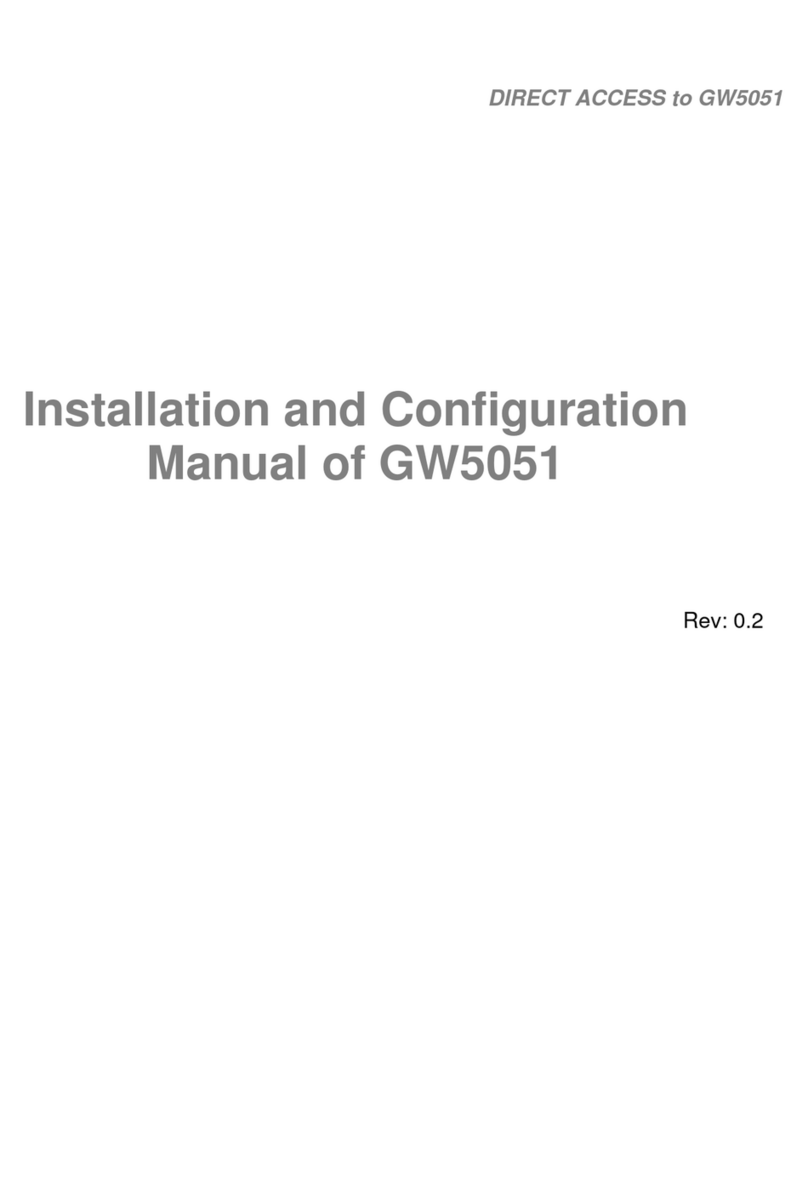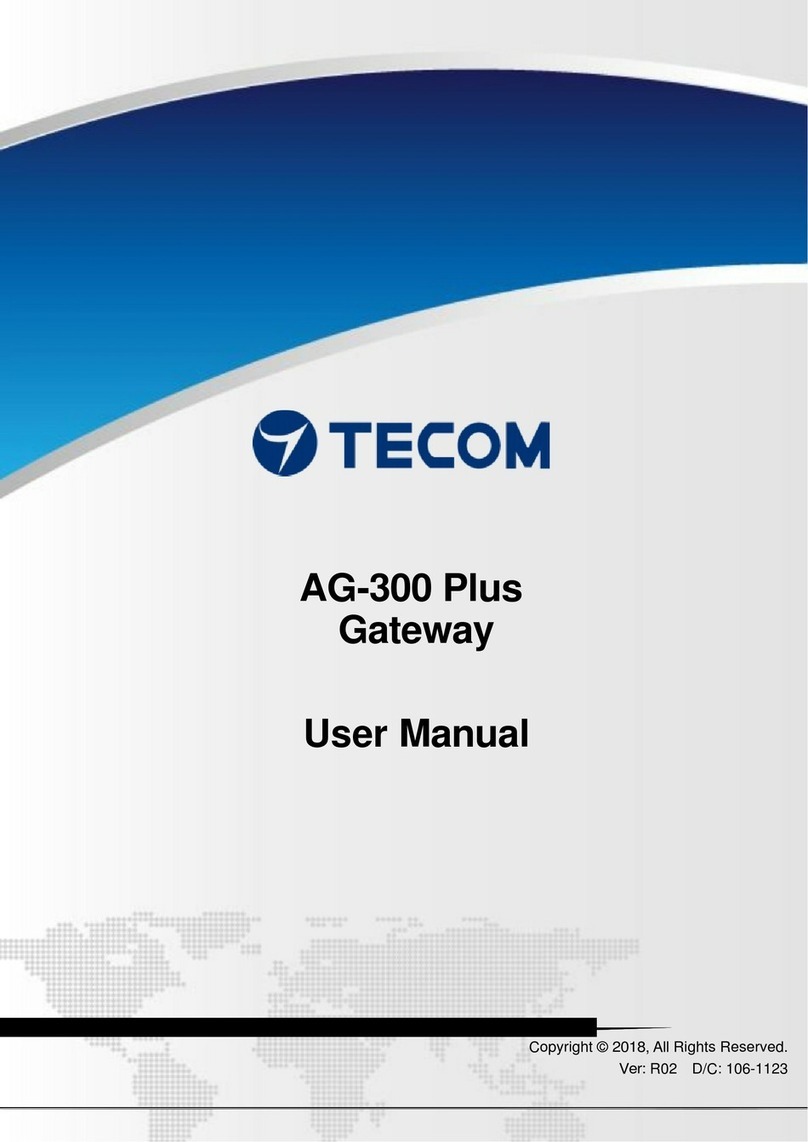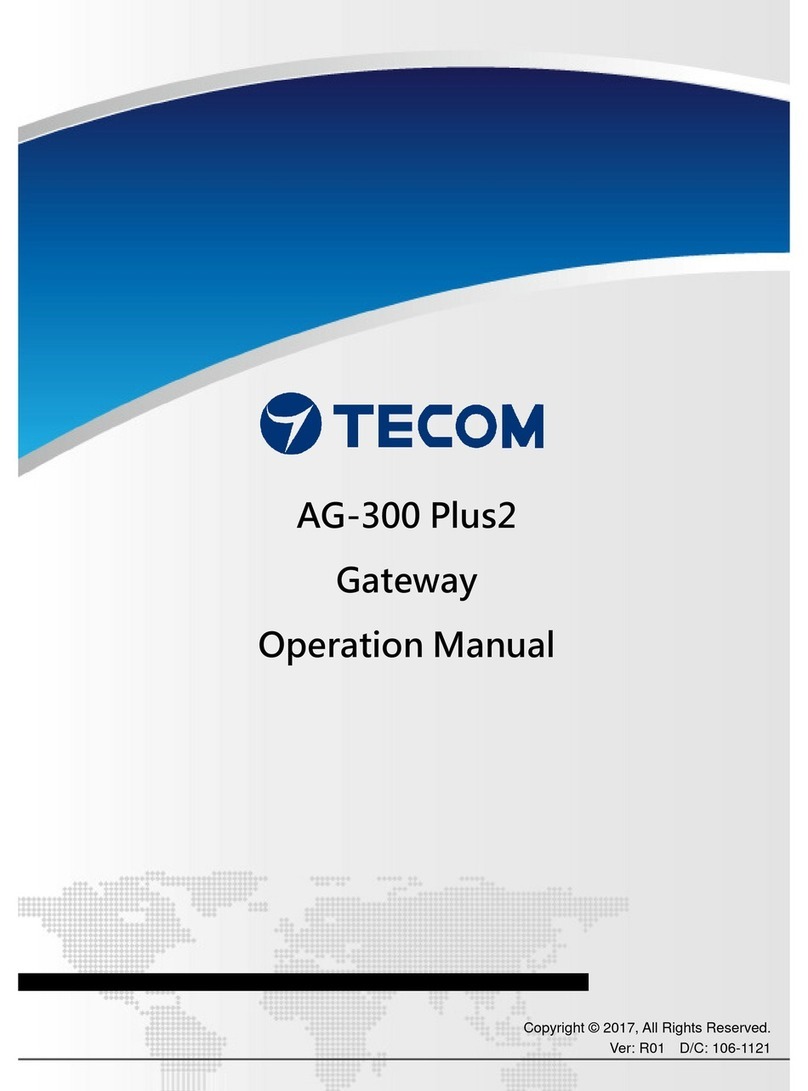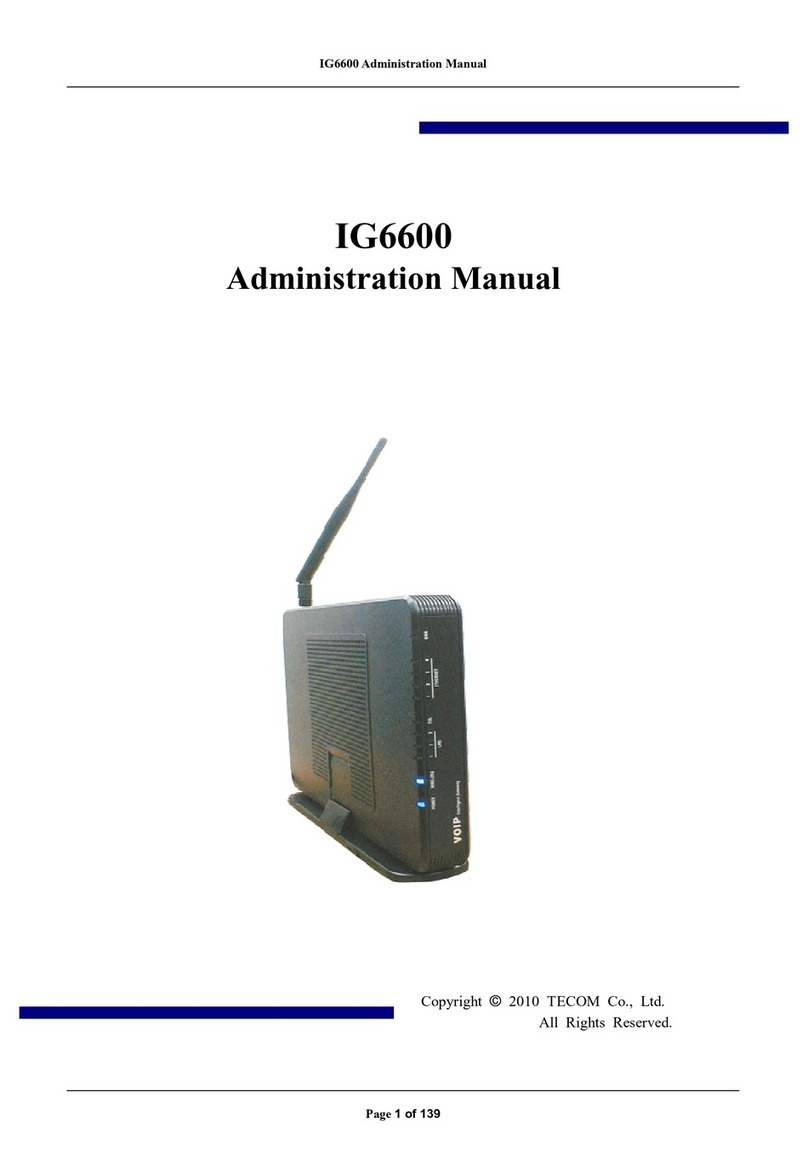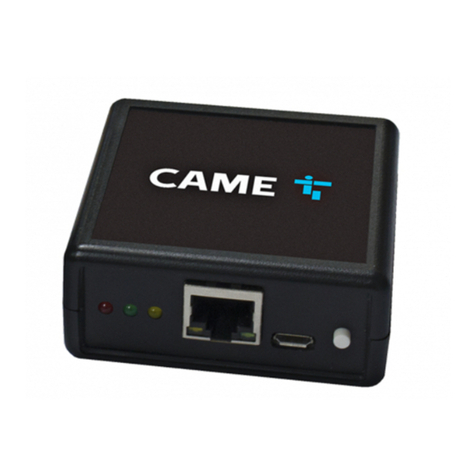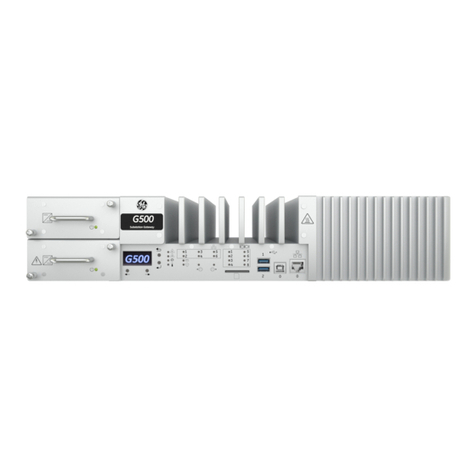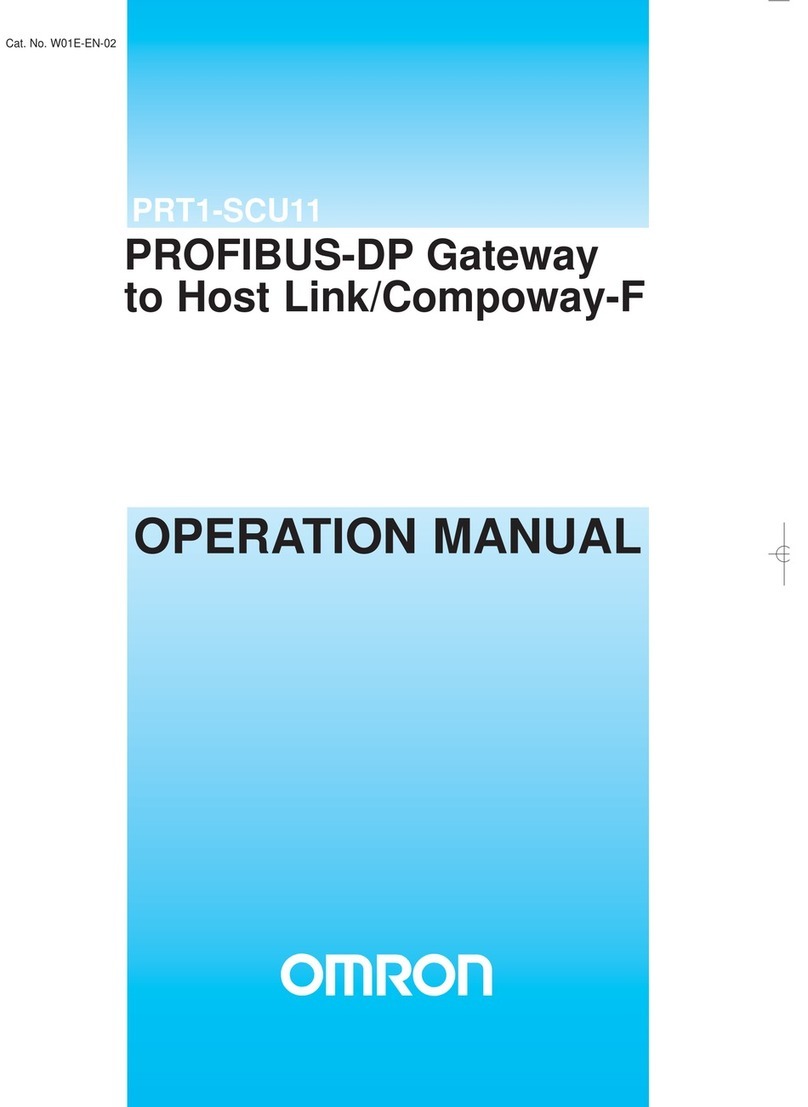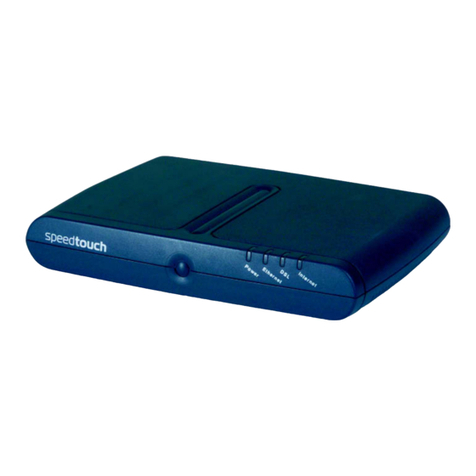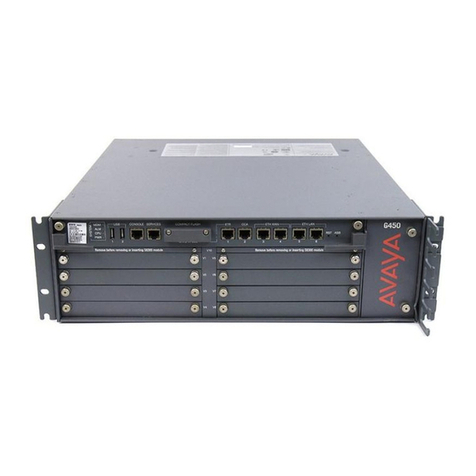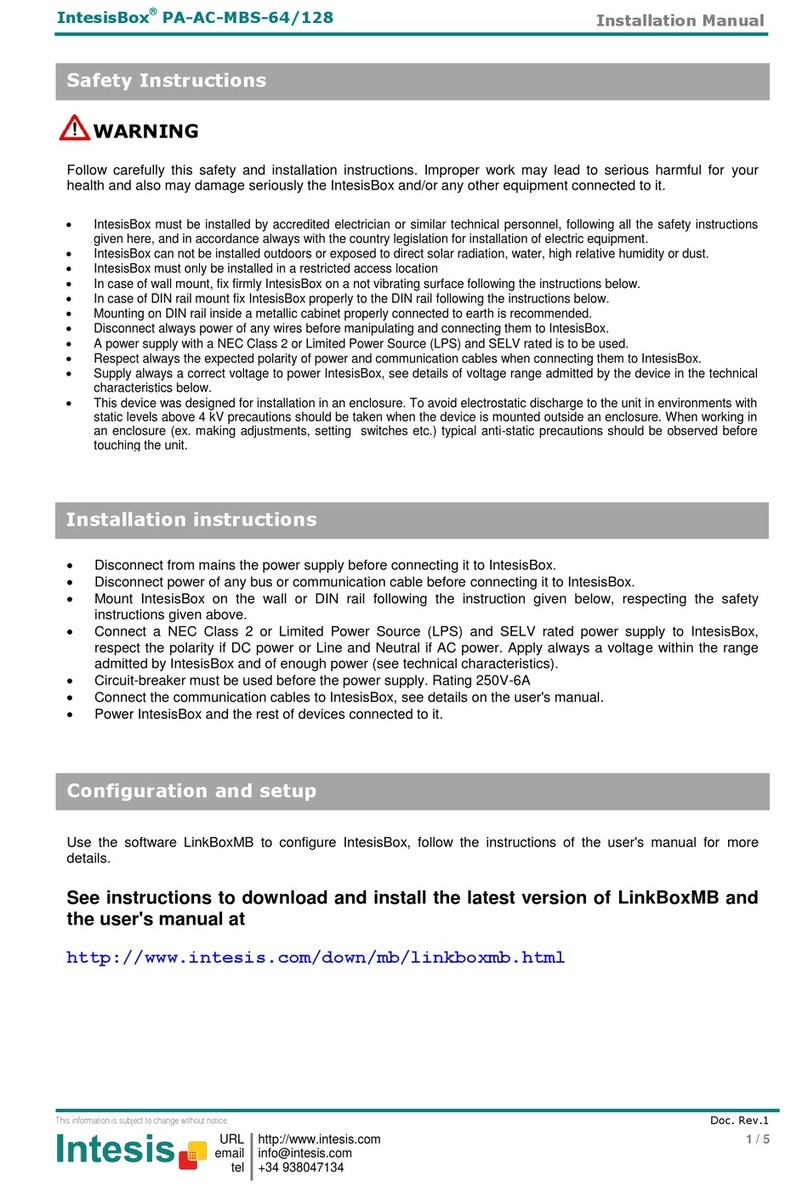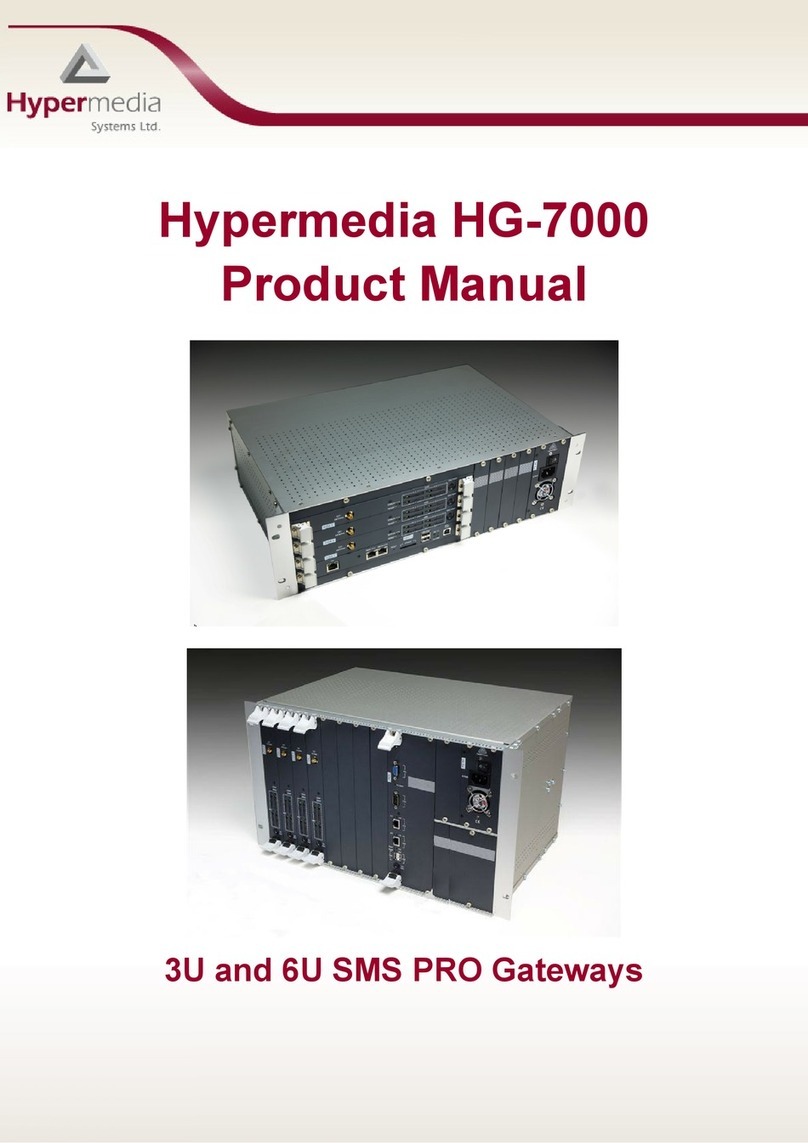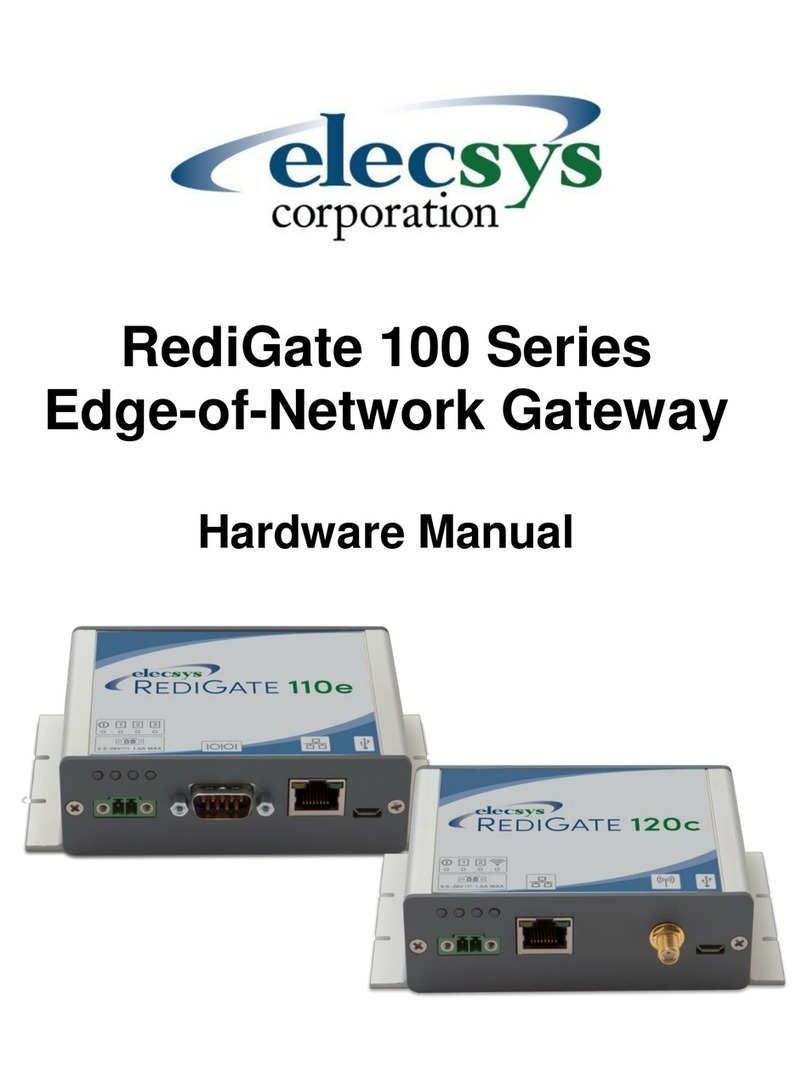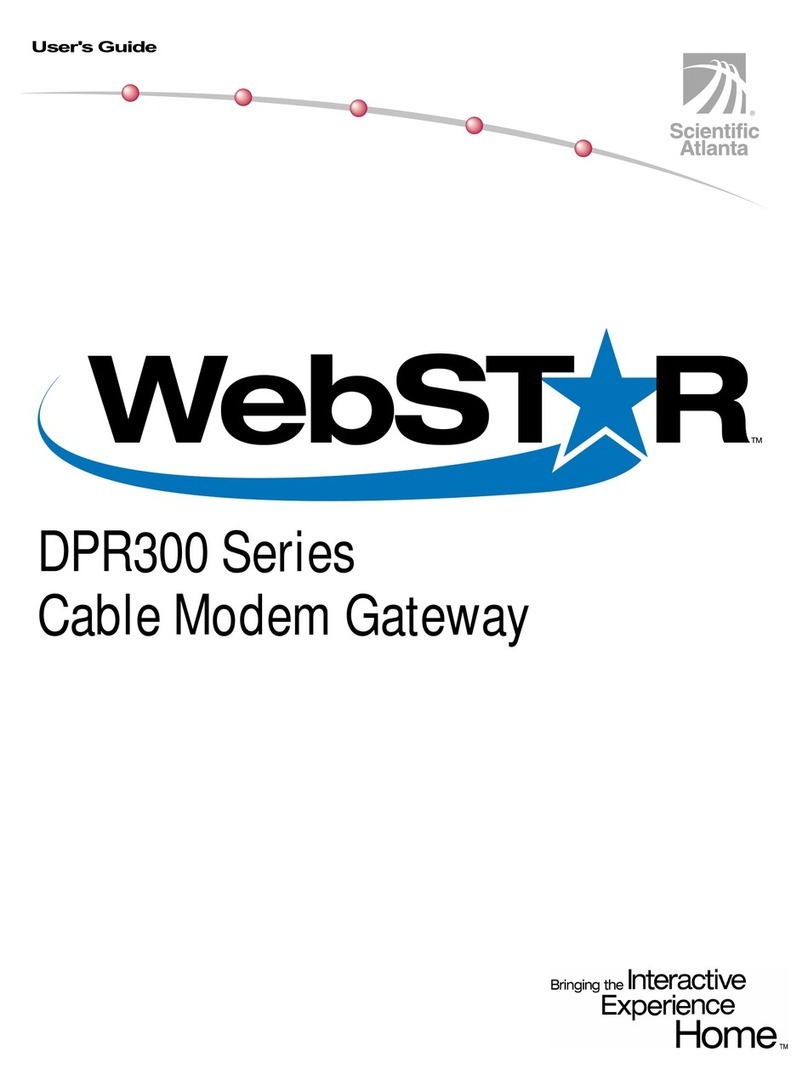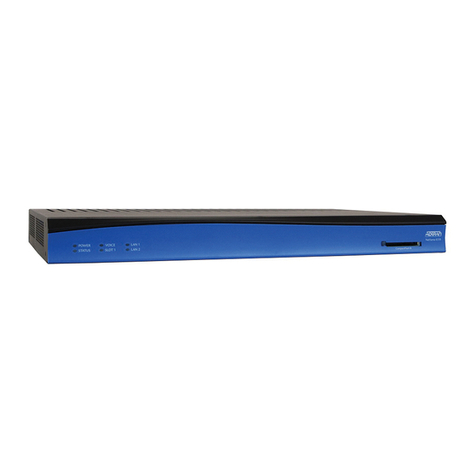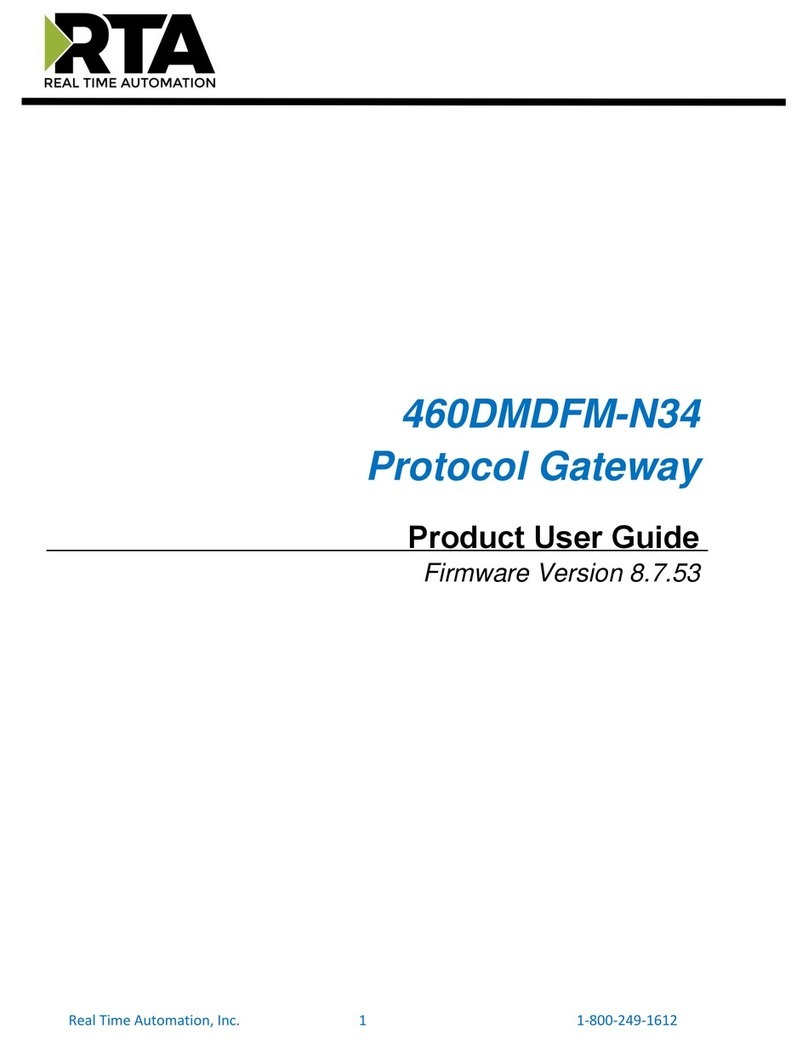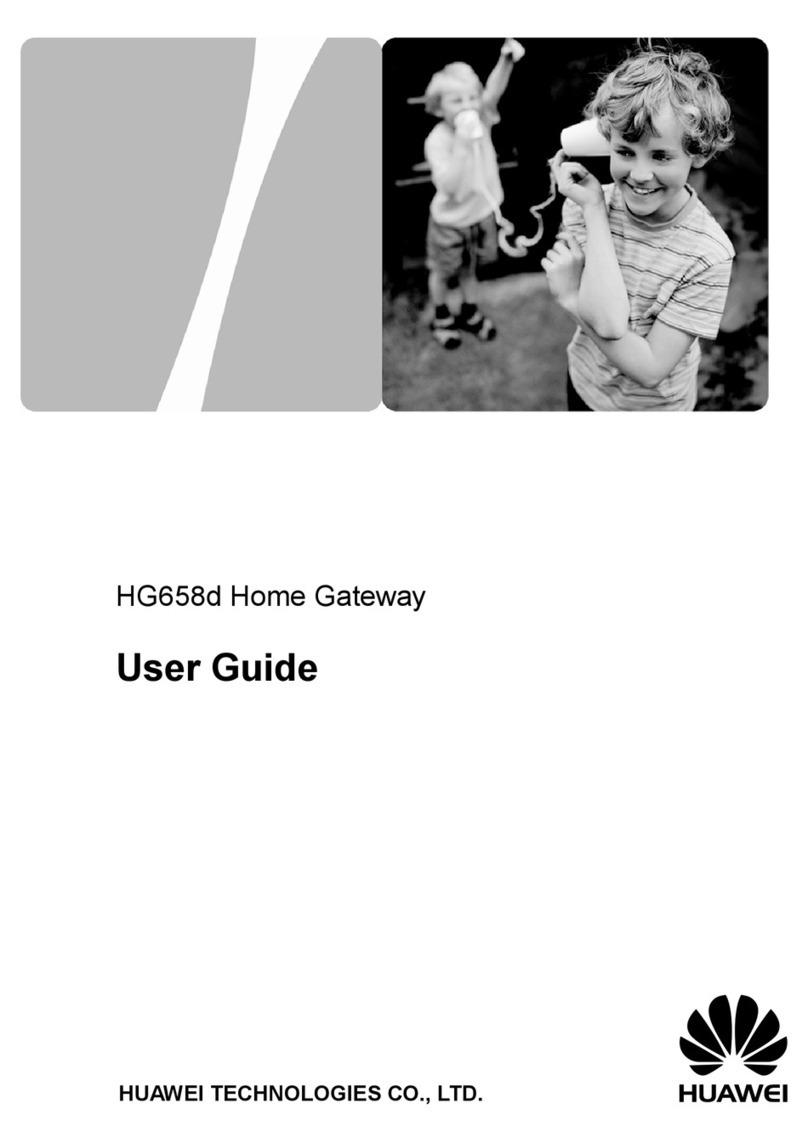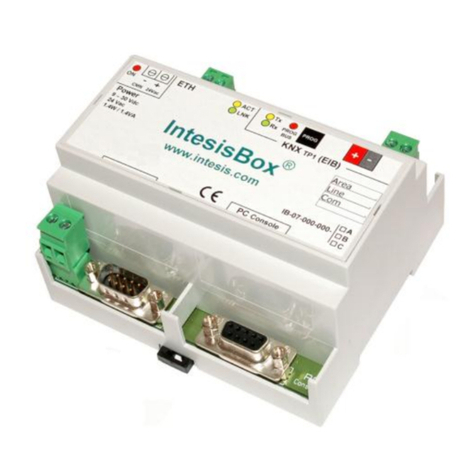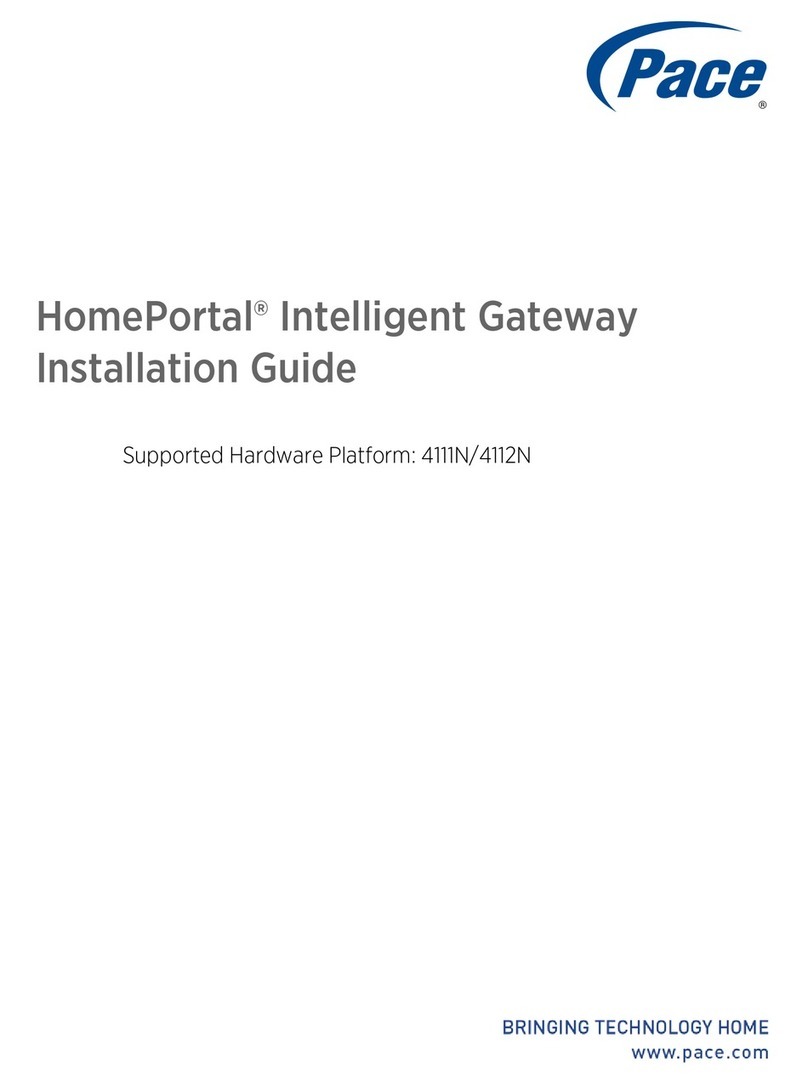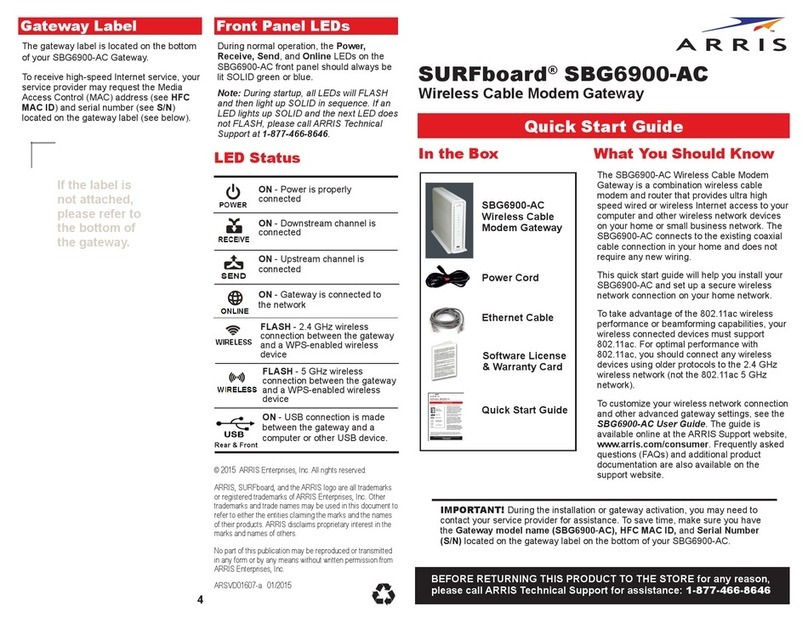TECOM IG6600 Instruction Manual

Document No.
Project Name:
IG6600
Date Issued:
2010-05-04
Revision:
0.1.0
IG6600 Administration Manual
Approved by:
Prepared by:
Ted Lu
Department :
Broadband Communication Dept.
HsinChu Tecom

IG6600 Administrative Guide
Revision History
Date Release Author Description
03-02-2010 0.0.5 Ted Lu First Draft (for IG6600 v0.0.5)
05-04-2010 0.1.0 Ted Lu Meet v0.1.0 release
Related Documents
Date Author Document

IG6600 Administrative Guide
Index
1. Introduction ...................................................................................................................................................... 6
2. Getting to Know the IG6600.......................................................................................................................... 8
2.1 Specifications............................................................................................................................................... 8
2.2 Front Panel................................................................................................................................................... 8
2.3 Rear Panel.................................................................................................................................................... 9
3. IG6600 Voice General Features................................................................................................................. 10
3.1. Access Control for Web Page....................................................................................................... 10
3.2. Answering Position ...................................................................................................................... 10
3.3. Auto Attendant & Voice Mail ....................................................................................................... 10
3.4. Auto Provisioning..........................................................................................................................11
3.5. Basic Call ......................................................................................................................................11
3.6. Call Abandon.................................................................................................................................11
3.7. Call Operator (Call Attendant) ..................................................................................................... 12
3.8. Call Pickup – Group ..................................................................................................................... 12
3.9. Call Restriction............................................................................................................................. 12
3.10. Call Routing ................................................................................................................................. 13
3.11. Caller ID Detection/Generation.................................................................................................... 13
3.12. Class Of Service (COS)................................................................................................................ 13
3.13. Daylight Saving Time................................................................................................................... 13
3.14. Default Set.................................................................................................................................... 13
3.15. Direct In Dialing (DID)................................................................................................................ 14
3.16. Direct Inward System Access (DISA) .......................................................................................... 14
3.17. Emergency Call ............................................................................................................................ 14
3.18. Extension Password...................................................................................................................... 14
3.19. Fax/Modem .................................................................................................................................. 14
3.20. Flash – Analog Port (SLT) Flash Recognition.............................................................................. 14
3.21. Gateway to Gateway (IGW Group).............................................................................................. 14
3.22. ICD Group (Hunt Group) ............................................................................................................. 15
3.23. IP Trunk........................................................................................................................................ 15
3.24. Message Waiting Indication (MWI) ............................................................................................. 15
3.25. Music on Hold.............................................................................................................................. 15
3.26. Numbering Plan............................................................................................................................ 16
3.27. Pause Insertion ............................................................................................................................. 16
3.28. PSTN Backup............................................................................................................................... 16
3.29. Registration Server ....................................................................................................................... 16
3.30. Service Mode................................................................................................................................ 16
3.31. Station Message Detailed Recording (SMDR)............................................................................. 17
3.32. System Speed Dial........................................................................................................................ 17
3.33. System Time & Date .................................................................................................................... 17
3.34. Trunk Group ................................................................................................................................. 17
3.35. Wizard Setup ................................................................................................................................ 17
4. IG6600 Voice Extension Features.............................................................................................................. 19
4.1. Agent Log On/Off – ICD Group .................................................................................................. 20
4.2. Alphanumeric Display.................................................................................................................. 20
4.3. Automatic Callback Busy............................................................................................................. 20
4.4. Auto Hold..................................................................................................................................... 20
4.5. Call Fork....................................................................................................................................... 20
4.6. Call Forward................................................................................................................................. 21
4.7. Call Hold ...................................................................................................................................... 21
4.8. Call Log........................................................................................................................................ 21
4.9. Call Park / Call Park Answer........................................................................................................ 22

IG6600 Administrative Guide
4.10. Call Pickup – Individual............................................................................................................... 22
4.11. Call Waiting.................................................................................................................................. 22
4.12. Caller Blocking............................................................................................................................. 22
4.13. CO Flash....................................................................................................................................... 22
4.14. Conference – 3 Way ..................................................................................................................... 22
4.15. COS Following............................................................................................................................. 22
4.16. Default Setting.............................................................................................................................. 22
4.17. Distinctive Ringing....................................................................................................................... 23
4.18. Do Not Disturb (DND)................................................................................................................. 23
4.19. DSS/EDM..................................................................................................................................... 23
4.20. Feature Key Programming ........................................................................................................... 23
4.21. Feature Button Reset .................................................................................................................... 23
4.22. Hold Reminder ............................................................................................................................. 23
4.23. LCD & Interactive Buttons .......................................................................................................... 23
4.24. Multi-Line Appearance................................................................................................................. 24
4.25. Mute ............................................................................................................................................. 24
4.26. On Hook Dialing .......................................................................................................................... 24
4.27. Paging (All/Group)....................................................................................................................... 24
4.28. Paging Allow/Deny ...................................................................................................................... 24
4.29. Phone Book .................................................................................................................................. 24
4.30. Phone Lock/Unlock...................................................................................................................... 24
4.31. Plug & Play .................................................................................................................................. 25
4.32. Reminder Tone ............................................................................................................................. 25
4.33. Service Mode Switching .............................................................................................................. 25
4.34. Transfer ........................................................................................................................................ 25
4.35. Trunk Ring Type........................................................................................................................... 25
4.36. Volume Control ............................................................................................................................ 25
4.37. Web Management......................................................................................................................... 26
5. Quick Installation........................................................................................................................................... 27
5.1 Connecting the IG6600.............................................................................................................................. 27
5.2 Wizard Setup.............................................................................................................................................. 27
5.2.1 WAN Setting................................................................................................................................... 27
5.2.2 LAN Setting.................................................................................................................................... 29
5.2.3 Wireless Basic................................................................................................................................. 30
5.2.4 Internet Time................................................................................................................................... 30
5.2.5 Numbering Plan .............................................................................................................................. 31
5.2.6 IP Trunk .......................................................................................................................................... 32
5.2.7 Call Routing Table .......................................................................................................................... 33
5.2.8 Wizard Setup Finished.................................................................................................................... 33
6. Configuration................................................................................................................................................... 35
6.1 Setup .......................................................................................................................................................... 35
6.2 Establish The Connection .......................................................................................................................... 35
6.3 Device Info ................................................................................................................................................ 37
6.3.1 Summary......................................................................................................................................... 37
6.3.2 Statistics.......................................................................................................................................... 37
6.3.2.1 LAN ............................................................................................................................................. 37
6.3.2.1 WAN ............................................................................................................................................ 37
6.3.3 Route............................................................................................................................................... 38
6.3.4 ARP................................................................................................................................................. 38
6.3.5 DHCP.............................................................................................................................................. 39
6.4 Advanced ................................................................................................................................................... 40
6.4.1 WAN ............................................................................................................................................... 40
6.4.2 LAN ................................................................................................................................................ 42
6.4.3 NAT................................................................................................................................................. 42
6.4.4 Security ........................................................................................................................................... 45
6.4.5 Parental Control .............................................................................................................................. 47
6.4.6 Quality of Service ........................................................................................................................... 49

IG6600 Administrative Guide
6.4.7 Routing ........................................................................................................................................... 50
6.4.8 Dynamic DNS................................................................................................................................. 51
6.4.9 Upnp ............................................................................................................................................... 52
6.4.10 File Server..................................................................................................................................... 53
6.4.11 Print Server ................................................................................................................................... 55
6.5 Wireless ..................................................................................................................................................... 59
6.5.1 Basic ............................................................................................................................................... 59
6.5.2 Security ........................................................................................................................................... 61
6.5.3 MAC Filter...................................................................................................................................... 64
6.5.4 Wireless Bridge............................................................................................................................... 64
6.5.5 Advanced ........................................................................................................................................ 65
6.5.6 Station Info ..................................................................................................................................... 68
6.5.7 Power Saving .................................................................................................................................. 68
6.6 Mobile Network......................................................................................................................................... 69
(It will be added later)...................................................................................................................................... 69
6.7 Voice .......................................................................................................................................................... 70
6.7.1 Phone .............................................................................................................................................. 70
6.7.2 Trunk............................................................................................................................................... 73
6.7.3 System............................................................................................................................................. 81
6.7.4 Voice Mail....................................................................................................................................... 90
6.7.5 Registered Phone ............................................................................................................................ 95
6.8 Management .............................................................................................................................................. 96
6.8.1 Settings ........................................................................................................................................... 96
6.8.2 System Log ..................................................................................................................................... 98
6.8.3 TR-069 Client ................................................................................................................................. 99
6.8.4 Time Setting.................................................................................................................................... 99
6.8.5 Access Control .............................................................................................................................. 101
6.8.6 Update Software ........................................................................................................................... 103
6.8.7 Reboot........................................................................................................................................... 104
6.9 Diagnostics .............................................................................................................................................. 105
6.9 Logout...................................................................................................................................................... 106
Appendix 1: Product Summary ............................................................................................................................. 107
Appendix 2: Feature Access Codes ..................................................................................................................110
Appendix 3: Auto Attendant and Voicemail System ........................................................................................113
Appendix 3.1 System Voice Prompts..............................................................................................................113
Appendix 3.1.1 Preset Voice Prompts.....................................................................................................113
Appendix 3.1.2 Voice Prompts Recording..............................................................................................116
Appendix 3.2 Flowchart .................................................................................................................................117
Appendix 3.2.1 Automated Attendant.....................................................................................................117
Appendix 3.2.2 Subscriber Voicemail Flowchart ...................................................................................119
Appendix 3.2.3 Mailbox Administer Flowchart .................................................................................... 121
Appendix 3.2.4 System Administrator’s Voicemail Flowchart.............................................................. 126
Appendix 4: PTS/PTC ........................................................................................................................................ 129
Install PTS ..................................................................................................................................................... 129
Update IG6600 Firmware .............................................................................................................................. 129
Update IG6600 Configuration File................................................................................................................ 130
Receive IG6600 Configuration File............................................................................................................... 131
Show Update Log .......................................................................................................................................... 134
Set Working Time .......................................................................................................................................... 135

IG6600 Administrative Guide
1. Introduction
The Tecom Smart Office system is an all-in-one solution which has rich feature set of IP
PBX telephone systems and IP networking systems. It has business essential PBX
features such as an auto-attendant, voice mail, multi-line appearances, three way call
conferencing, intercom, music on hold, call-forwarding and much more. The IG6600
system opens up access to the benefits of VoIP, including low cost long distance service,
and one network for both voice and data.
The IG6600 is so easy to configure that a fully working system can be set up in minutes.
Plug and Play feature allows new telephones to be automatically detected and registered
when they are connected. The IG6600 is so easy to be managed and configured by its
integrated web server.
The IG6600 system can work with any SIP based IP Phone. However, it is the best to
work with Tecom’s IP Phones IP2032, IP2061 and IP2062 to take advantages of powerful
business features such as plug & play, all paging/group paging, multi line appearances,
etc….The IG6600 has a FXS port to support traditional analog devices such as telephone,
answering machine, FAX machine.
It must not be an ordinary Integrated Access Device (IAD) solution, nor a mere ATA
solution, but with elaborated and popular Voice-centric features, so as to be able to
penetrate conventional Voice-centric market
Interfaces
WAN Interface: 10BASE-T/100BASE-TX/1000BASE-T Gigabit Ethernet port
CO Interface: 6 FXO (Loop Start, for PSTN)
Analog Device Interface: 1 FXS (For Analog Telephone or FAX)
LAN Interface: 1 Ethernet (10BASE-T/100BASE-TX)

IG6600 Administrative Guide
Built-in 802.11a/b/g/n WiFi access point
USB Interface : Connects to your USB storage devices or printer.
Terminals
1 Analog Terminal (Analog Telephone or FAX)
24 IP Stations (Wired or WiFi IP-Phone)
In principle, the Administration is required to do the following things:
(1) To understand the architecture, resources, and devices of whole environment
which will be involved with the VoIP communications.
(2) To build a common setting file for most users.
(3) To configure each phone and install them into the network.
(4) To configure each interfaces and install them into IG6600.
(5) And to solve the problems what users encounter during operation.

IG6600 Administrative Guide
2. Getting to Know the IG6600
2.1 Specifications
Feature Additional Info
Main Processor 400MHz Dual-Core MIPS processor Broadcom BCM6369
Processor SDRAM External 64MB
Processor Flash ROM External 16MB
Supplementary Processor 1x DSP Mindspeed M82351
System Flash (Voice Mail) 512MB
Giga WAN PHY chip Broadcom BCM5481
System Power 12V/1.5A
Standards IEEE802.11a/b/g/n, IEEE802.3
Ports 1×WAN,1×LAN,1×FXS ,6×FXO
Buttons Reset, WiFi On/Off and WPS
Cabling RJ-45, RJ-11
LEDs POWER, WIRELESS, TEL, 6×LINE, LAN, WAN
EMI/EMC FCC Part15 Class B
Operating Temp .0ºC to 40ºC (32ºF to 104ºF)
Storage Temp. -20ºC to 70ºC (-4ºF to 158ºF)
Operating Humidity
10% to 80% relative humidity, Non-Condensing
Environmental
Storage Humidity 10% to 90% Non-Condensing
2.2 Front Panel
The front panel contains several LEDs that indicate the status of the IG6600.
Figure 2-1. Front Panel of IG6600
LED Name Color
Status Description
On Power on.
POWER Blue Off Power off.
On Wireless LAN initialization success.
WIRELESS Blue Off Wireless LAN is not present.
On Phone is busy.
TEL Blue Off Phone is idle.
On PSTN Line is busy.
LINE (1-6) Blue Off PSTN Line is idle.
On LAN connected.
Off LAN network connection not present.
LAN Blue
Flashing
LAN activity present (traffic in either direction).
On WAN connected. WAN Blue
Off WAN network connection not present.

IG6600 Administrative Guide
Flashing
WAN activity present (traffic in either direction).
Red On Ping gateway fail or DHCP fail.
2.3 Rear Panel
The rear panel contains the ports for the IG6600's data and power connections.
Figure 2-2. Rear Panel of IG6600
Label Function
WAN RJ-45 connector: Connects the device to your cable modem, or to your
ADSL Modem. It’s to connect to the remote network.
LAN RJ-45 connector: Connects the device to your PC's Ethernet port, or to the
uplink port on your LAN's hub.
Line (1-6) RJ-11 connector: Connects the device to your PSTN lines.
TEL RJ-11 connector: Connects the device to your analog phone.
USB Connects to your USB storage devices or printer.
Power Connects to the supplied power converter cable.

IG6600 Administrative Guide
Quick Installa
Copyright 2010 Tecom, Co. LTD. All rights reserved Page 10 of 136
3. IG6600 Voice General Features
3.1. Access Control for Web Page
The Access Control settings allow the System Administrator to configure the Web Port,
Service Control List, IP Address Access Control mode and password for Administrator,
Supporter and User.
IG6600 also provide an external user access to the internal IP phone’s Web page. The
Registered Phone page will list all registered phones with their IP links. Clicking a
specific link will open that specific IP phone’s Web page.
IG6600 provides three Access mode for Web Page
- Administrator mode: unrestricted access and program
- Support Mode: allow an ISP technician to maintain and run diagnostics
- User Mode: view some configuration settings and statistics.
3.2. Answering Position
For incoming calls from the Public Switched Telephone Network (PSTN) (via analog CO
or FXO ports), the IG6600 provides the flexibility to ring specific destinations. The
IG6600 provides the ability to ring Auto Attendant. The IG6600 also provides the ability
to simultaneously ring up to 24 extensions when programmed in a ICD Hunt Group, or
the Operator in accordance with the system service mode (day or night). The user can
also assign a line to ring directly to an extension. Incoming VoIP calls from a registered
ITSP can be programmed and routed in the same manner as the analog CO (FXO)
ports.
3.3. Auto Attendant & Voice Mail
The IG6600 Auto Attendant can greatly enhance business productivity by providing
either a full-time automated attendant to handle all incoming system calls or part-time
automated attendant to handle overflow traffic. The Voice Mail Module provides up to 16
hours recording time that are shared by all extensions. The system can handle four
simultaneous calls with following functions.
Auto Attendant Functions
The Auto Attendant provides an incoming caller with a customized welcome greeting
and specific prompts that will describe the options available to the caller.
Play the welcome greeting messages depending on the system service
mode: Day, Night, Noon, and Holiday.
Route the call to the appropriate destination (extension or UCD group) with
the dialing digits.
Leave a message to a particular mailbox.
Make an outside call via another trunkline (PSTN or SIP-Trunk).
Voice Mail Functions

IG6600 Administrative Guide
Copyright 2010 Tecom, Co. LTD. All rights reserved Page 11 of 136
Delete, save, or skip messages.
Forward messages to other mailboxes.
Envelop information indicating the time and date of the message received;
sender information will also be included in the email notification.
Change personal greeting and password.
Expert mode support (playback controls when reviewing messages).
Send a notification via email when a new message is left.
Send voice message as the attachment of the email in WAV format.
The maximum recording length for each call is 1800 seconds.
When 90% of the VM size is used, it shows “Message Full” on the all
IP20xx’s LCD.
For each extension, the maximum number of Voice Mail is 200.
For each leaving message, it's saved 1 - 7 days or infinite
Voice Messages
Provide two languages service for the all voice files.
Provide G711-ulaw voice files.
Administrators can record the all voice messages by themselves.
Administrators can update, backup or delete the all voice messages from/to
the PC.
3.4. Auto Provisioning
WAN Management Protocol (TR-069) allows an Auto-Configuration Server (ACS) to
perform auto-configuration, provision, collection, and diagnostics to this device.
Firmware upgrade or vendor configuration file backup can be done remotely on ACS
server. Select the desired values and click "Save Settings" to configure the TR-069 client
options.
IG6600 also provides an Auto Provision Server (APS) to update IG6600 FW, Update /
Retrieve IG6600 Configuration and the registered IP20xx FW
3.5. Basic Call
To make an intercom call, dial a Station number (IP Terminal, POTS) or a Voice Mail
number.
To make an outside call, dial a phone number. IG6600 chooses a line (PSTN line, IP
trunk, another IG6600) via Call Routing Table to dial out. If it includes “p” in the phone
number, and the call is dialed through PSTN Trunk, it will pause for a pre-configured
time.
To make an outside call, dial a PSTN, an IP Trunk or a Trunk Group number first. After
hearing dial tone, dial the phone number.
3.6. Call Abandon
For every PSTN call, IG6600 provides the facility to monitor the call status. If the remote
party hangs up, the ongoing call must be terminated.

IG6600 Administrative Guide
Copyright 2010 Tecom, Co. LTD. All rights reserved Page 12 of 136
The PSTN line monitor is accomplished through monitoring the loop-break signal,
polarity reversal or busy tone. The value range of loop-break signal is:
0/100/200/…/1000 ms.
3.7. Call Operator (Call Attendant)
IG6600 supports one operator. Any extension can be designated as the operator
through system configuration.
One primary operator may be assigned in the system. The standard IP phone will serve
as the operator telephone. When assigned as operator, this extension supports general
system functions.
While the internal extension dials Operator Directory Number ("0" at default), or the
outside party dials "0" when Auto Attendant plays the welcome message, these calls will
be stored into Operator Queue. The Operator is First-In-First-Out to service these calls.
At the waiting time, the calling party will be on Music-On-Hold state.
A second (alternate) operator position may be designated for common sharing of
incoming operator calls during peak traffic period.
3.8. Call Pickup – Group
You may answer trunk calls at another extension using the function. The feature allows
you to easily access calls ringing via the single digit “*”.
3.9. Call Restriction
IG6600 provides sophisticated monitoring of digits dialed on PSTN/IP Trunks. If a digit or
range of digits dialed on a Trunk line is inconsistent with the dialing extension’s COS, the
call is denied. This calling COS criteria can be applied to local calls, long distance calls,
and specific numbers that are considered allowed in areas where other numbers may be
restricted.
In the call restriction table, it provides the following programming items:
From/To
The allowed intervals are made up of a From and To entry which establish a
numeric range. For example, an entry of “From 1700” , “To 1800” would include
the following range of numbers as the leading: 1700, 1701, 1702, …1799, 1800.
Each From/To entry can be from 1 to 13 digits long and may contain any digit 0-9.
The “From” entry must be less than or equal to the “To” entry.Each From/To entry
can be from 1 to 13 digits long and may contain any digit 0-9, or X (X representing
any digit). The :From” entry must be less than or equal to the “To” entry.
Trunk Access
IG6600 checks the field only when a call matches the associated allowed
interval. If the field is set to “Y”, the entry is valid when the trunk is accessed
previously. If the field is set to “N”, the trunk isn’t accessed previously. The trunk
will be accessed through Call Routing Table. If he option is set to “YN”, the entry
is valid no matter the trunk is accessed or not previously.
COS
The COS setting is defined by the allowed intervals. “Y” allows an extension with
the COS or higher priority to dial the number(s) specified in that range.

IG6600 Administrative Guide
Copyright 2010 Tecom, Co. LTD. All rights reserved Page 13 of 136
3.10. Call Routing
The Call Routing feature automatically routes outgoing calls using the most appropriate
route. The appropriate route is determined based on the number dialed. If necessary,
IG6600 can automatically modify the dialed number by deleting and inserting digits.
The call routing destination is a PSTN line, an IP line, a line group or another IG6600. It
allows you to configure each entry in the Call Routing Table which contains a routing
rule for outgoing calls:
- From/To setting defines the number range
- Min/Max defines the match length
- Del/Insert can change the target number
- Destination defines the outbound call interface trunk
3.11. Caller ID Detection/Generation
IG6600 provides the ability to detect the calling party identification provided by CO via
PSTN lines or by Uplink Server via IP trunks. This data when received by the telephone
carrier will be displayed on all ringing IP phones.
IG6600 also provide Caller ID Generation to the Caller ID equipped Single Line
Telephone.
3.12. Class Of Service (COS)
IG6600 provides 8 Classes of Service (COS) for assignment of outside line
dialing-privileges. Each extension may be assigned one Day-COS and one Night-COS.
The Extension COS is primarily used for restriction and control of long distance dialing.
COS 0 is the highest priority. COS 7 is the lowest one.
3.13. Daylight Saving Time
Daylight Saving Time (DST) feature supports auto adjustment for daylight saving time. It
allows you to configure the Daylight Saving Time (DST) which includes support for auto
adjustment of daylight saving time.
- Internet Time: it obeys the international standard rule.
- Manual DST Rule: it allows you to define your own Daylight Savings Time Rule.
3.14. Default Set
Clear all settings and return the IG6600 set to the factory condition.
When rebooting the IG6600 to the default, some settings for the registered Tecom IP
Phones (IP2032, IP2061 and IP2062) are reset to the default also.
- Line Keys
- Call Forward
- DND
- Page Deny
- Auto Answer
- Phone Lock
- Call Waiting

IG6600 Administrative Guide
Copyright 2010 Tecom, Co. LTD. All rights reserved Page 14 of 136
3.15. Direct In Dialing (DID)
IG6600 provides a Direct In Dialing Table for IP Trunks. It will be able to offer its
individual phone number for each extension.
IG6600 provides 50 entries in the Direct In Dialing Table. Each entry includes
- DID Number
- Outgoing Call ID
- Extension Number
- Display Name
3.16. Direct Inward System Access (DISA)
The feature allows you to remotely access IG6600 lines to make the outside calls. The
current PSTN/IP lines are all DISA lines. While ringing to Auto Attendant, the outside
callers have direct access to extensions, PSTN/IP lines, Call Routing and Trunk Groups.
The out-calling is secured by means of verified passwords against the assigned
extension number. The use is accomplished only when a valid extension number has
been entered and when the password entered matches that stored for the extension
number entered.
3.17. Emergency Call
IG6600 allows you configure five Emergency Call numbers and lines with which
Emergency Calls are sent out. Any user can make an Emergency Call regardless of its
Call Routing table, Call Restriction, and Phone Lock, when they dial a pre-configured
Emergency Call number. The numbers of Emergency Call must not collide with the
numbers in Numbering Plan.
It allows to program 5 emergency numbers. “911” is in it by default.
3.18. Extension Password
All extensions of the IG6600 system have an associated User Password. The Password
is applied to Voice Mail service, and some system feature settings (Phone Lock, COS
Following, DISA).
3.19. Fax/Modem
IG6600 supports FAX/modem tone detection and auto-fallback to G.711.
3.20. Flash – Analog Port (SLT) Flash Recognition
Flash is the momentary operation of the hook-switch at the analog device, which can be
deciphered by the IG6600 system in such a way that the previous call in progress is held,
or placed in a status of transfer awaiting further instructions from the user.
3.21. Gateway to Gateway (IGW Group)
A call may be placed from one IG6600 to another IG6600 via the Call Routing Table.

IG6600 Administrative Guide
Copyright 2010 Tecom, Co. LTD. All rights reserved Page 15 of 136
The call Routing Table allows the user to make a direct call to an extension in another
IG6600 It also allows the user to share the PSTN or IP Trunks in another IG6600 to
make an outside call.
In an IGW Group, one Master IG6600 and at most 9 Slave IG6600s are available. Master
IG6600 must have a public/static IP address. Master and all Slave IG6600 share one
password for authentication. If the IP address of Master is set in a Slave IG6600, Slave
IG6600 sends its IP address, name, and password to the Master. Master IG6600 verifies
the received password and name. If the password is valid and the name is not duplicated,
Master IG6600 sends the IGW list to all Slave IG6600s.
3.22. ICD Group (Hunt Group)
IG6600 supports 4 ICD Groups. Each ICD Group can have up to 25 members. There are
three kinds of ICD Group mode – All Ring, Linear, and Distributed. For All Ring mode,
incoming Trunk calls ring all member extensions simultaneously. For Linear mode,
incoming call is put into a queue and then distributed from the first extension. For
Distributed mode, it is the same as Linear but selection of an extension is uniformed.
If more than one call rings at the same time, the first agent to go off hook will be
connected to the call that has been ringing the longest.
For unanswered Trunk call, it will be forwarded to a Reroute destination. The Reroute
destination can be Auto Attendant or the first member’s Voice Mailbox.
The missed ICD Group calls are recorded in ICD Call Log. It records the last 100 missed
ICD Group calls.
3.23. IP Trunk
IG6600 can register up to 8 SIP Uplink Servers. The extensions may make a call to the
users of the Uplink Servers, or any user in the world through the Uplink Servers.
SIP messages, including INVITE, re-INVITE, ACK, CANCEL, OPTIONS, BYE,
REGISTER, INFO, REFER, SUSCRIBE/NOTIFY and REPLACE messages
SIP Proxy, SIP Outbound Proxy, Registrar, and Outbound Registrar
Auto Registration when Power-on or period
Session Timer support
Support IP address, domain name, user name, display name for SIP URL.
3.24. Message Waiting Indication (MWI)
It’s a Voice Mail feature. When somebody leaves messages, the router will inform the
phones, and phones’ LCD will display new voice mails information, and its lamp will flash
accordingly.
3.25. Music on Hold
Any PSTN/IP line calls placed on hold will give music to the other external party.

IG6600 Administrative Guide
Copyright 2010 Tecom, Co. LTD. All rights reserved Page 16 of 136
3.26. Numbering Plan
The Numbering Plan refers to the structure of dialed access to the various resources
that are part of the system. IG6600 also allows for a very flexible configuration
numbering for the various system resources.
IG6600 provides the following resources to be programmed in Numbering Plan.
Extension Number
Operator Number
Voice Mail Service Number
PSTN Line Number
IP Trunk Numbers
All Paging Number
Paging Group Number
ICD Group Number
System Speed Dial Number
Call Park Number
Pick Up Number
3.27. Pause Insertion
Pause Insertion is used to generate an intentional delay in dialing on Outgoing FXO line
calls. A pause can or a combination of pauses may be stored in the dialed number, Call
Routing Table or a Speed Dial number. It uses “P” or “p” as the Pause digit.
3.28. PSTN Backup
In case of power failure, IG6600 automatically switches the first PSTN line to the
Single-line analog phone. The other PSTN lines are not supported
3.29. Registration Server
The IG6600 combines Proxy and Registrar servers in its application. For a Registrar
server, it acts as the front end to the location service for a domain, reading and writing
mappings based on the contents of REGISTER requests. The location service is then
typically consulted by a Proxy server.
3.30. Service Mode
IG6600 provide Day and night settings for each weekday in service mode page. And
during different time, Trunk incoming call will be forwarded to different extensions
according to the settings.

IG6600 Administrative Guide
Copyright 2010 Tecom, Co. LTD. All rights reserved Page 17 of 136
3.31. Station Message Detailed Recording (SMDR)
The feature allows the administration to track all incoming and outgoing outside call
traffic, chronologically by extension number. SMDR is output from the standard Syslog
(None/LAN/WAN/Both)
SMDR information includes Trunk Line used, extension number, time and date the call
was placed, number dialed, duration of the call. IG6600 will also provide Outgoing Call
Duration Start Time to the PSTN call.
3.32. System Speed Dial
IG6600 stores frequently dialed numbers. These Speed Dial Numbers are accessed for
dialing by the associated Speed Dial Directory Numbers. The Speed Dial Directory
Numbers are assigned in Numbering Table. The Speed Dial is only for outgoing calls.
IG6600 stores up to 100 Speed Dial Numbers. In the Speed Dial Number, it’s allowed to
store Phone number up to 20 digits in length. Call Restriction and Call Routing are
applied and extensions may utilize only those numbers allowed based on their extension
COS. The actual dial sent to trunk is not displayed on IP phone’s LCD.
3.33. System Time & Date
The IG6600 system provides a built-in time clock to track System Time for reference in
certain features such as day/night service mode. This clock has the ability to
automatically adjust with network NTP server through internet.
System Time & Date can be applied to Tecom IP20xx Phone if it’s on IG6600’s LAN side,
or on WAN side with the same Router as IG6600’s..
3.34. Trunk Group
The Trunk Group feature is used to assign each PSTN Trunk and IP Trunk to a specific
Trunk Group. Each Trunk can be assigned to only one Trunk Group. The Trunk group
assignment is used for Trunk pool access. If setting some PSTN trunks and some IP
trunks into the same Trunk Group, the trunk access sequence will depend on the access
priority. The GW6000 provides up to 4 Trunk Groups. All PSTN Trunks are assigned to
default Trunk Group 1 and all IP Trunks are assigned to default Trunk Group 2. For the
four groups you can choose IP first or PSTN first if programming PSTN and IP Trunk in
the same group. This will take effect if call routing entry’s destination has been set as
Group choice
3.35. Wizard Setup
The IG6600 has a setup Wizard that provides the system administrator with a series of
step-by-step operations. The setup Wizard starts automatically when the IG6600 is
powered up for the first time, or if the system is reset to default configuration via the
reset switch on the IG6600 unit. The following programming/operation areas are
supported through the setup Wizard:

IG6600 Administrative Guide
Copyright 2010 Tecom, Co. LTD. All rights reserved Page 18 of 136
WAN Setting
LAN Setting
Wireless Basic
Wireless Security
Internet Time
Numbering Plan
IP Trunk
Call Routing Table

IG6600 Administrative Guide
Copyright 2010 Tecom, Co. LTD. All rights reserved Page 19 of 136
4. IG6600 Voice Extension Features
IG6600 follows SIP standard to serve SIP phones. Basically, telephone features that
meets SIP standard can be applied in IG6600.
Tecom IP20xx phone (IP2032/IP2061/IP2062) supports many phone features. But for
adding some traditional KTS features that are not defined definitely in SIP protocol,
some specified information are transmitted between IG6600 and IP2xxx Phones. This
section introduces these special phone features. Some features are only for IP20xx
phones and/or FXS phone.
The following features depend on whether the phone provides.
Feature Tecom
IP20xx
FXS Other
SIP Phone
Agent Log On/Off – ICD Group Yes* Yes* No
Alphanumeric Display Yes Depends
Depends
Automatic Callback Busy Yes* Yes* No
Auto Hold Yes No Depends
Call Fork Yes Yes No
Call Forward – Direct Yes* Yes* Depends
Call Forward – Busy Yes* Yes* Depends
Call Forward – No Answer Yes* Yes* Depends
Call Forward – DND Yes* Yes* Depends
Call Forward – Follow Me Yes* Yes* No
Call Hold Yes Yes Depends
Call Log Yes No Depends
Call Park Yes No No
Call Park Answer Yes Yes Yes
Call Waiting Yes* Yes* Depends
Caller Blocking Yes No* Depends
CO Flash Yes No No
Conference 3 Way Yes No Depends
COS Following Yes* Yes* No
Default Setting Yes* Yes* Depends
Distinctive Ringing Yes No Depends
Do Not Disturb Yes* Yes* Depends
DSS/EDM IP2061 No No
Feature Key Programming Yes* No No
Flash – CO/PBX Lines Yes Yes No
Hold Reminder Yes Yes Depends
LCD & Interactive Buttons Yes No Depends
Multi-Line Appearance Yes No Depends
Mute Yes No Depends
On Hook Dialing Yes Depends
Depends
Page (All/Group) - Paging Yes Yes Yes
Page (All/Group) - Paged Yes No No
Page Answer Yes No No
Page Allow / Deny Yes* No No
Phone Book Yes No Depends

IG6600 Administrative Guide
Copyright 2010 Tecom, Co. LTD. All rights reserved Page 20 of 136
Phone Lock/Unlock Yes* Yes* No
Plug and Play Yes Yes No
Reminder Tone Yes Yes Depends
Service Mode Switching Yes* Yes* No
Transfer Yes Yes Depends
Trunk Ring Type Yes Yes Depends
Web Management Yes No Depends
Volume Control Yes Depends
Depends
NOTE: the word “Depends” means that the features depend on whether the phone
provides.
4.1. Agent Log On/Off – ICD Group
Extensions can log on or log off from ICD group.
Enable Agent Log On feature, dial *91.
Disable Agent Log On feature, dial **91.
If an extension disables the Agent Log On feature, the extension should log off from all
ICD groups it belongs to.
4.2. Alphanumeric Display
The IP Phone extension provides a graphic LCD that supports 64 alphanumeric
characters. The LCD enhances many system features.
4.3. Automatic Callback Busy
IP20xx supports Automatic Callback Busy. When the callee has no session resource,
the caller will hear busy tone.
The caller can dial “6” to get the Automatic Callback Busy feature.
The confirmation tone will be heard and come back to idle status. When the callee is no
longer in busy status, the caller will hear call back ring.
Disable the Automatic Callback Busy feature, dial *66.
4.4. Auto Hold
You may enable the feature to simplify call handling and avoid accidental “lost” calls.
Hold will automatically place any call that is currently connected at your phone on hold
whenever a Trunk line button is pressed.
4.5. Call Fork
IG6600 supports to ring another extension or an outside destination via IP Trunk
simultaneously when the extension gets an incoming call. When the call is answered by
one of the both parties, the call at the other party will stop ringing automatically.
To Activate (Type: 0 – ICM; 1 – Outside; 2 – Both)
*26 + Type + Ext No
*26 + Type + * + (PSWD) + * + Outside Number
To Cancel
**26
Call Fork is executed if Caller is IP20xx, FXS or Trunk. Call Fork is not applied to
Operator call, Paging call and ICD call
Other manuals for IG6600
2
Table of contents
Other TECOM Gateway manuals
